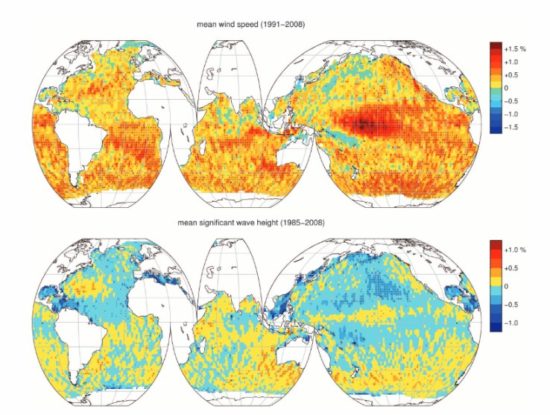May 5, 2019 – The largest carbon sink on our planet is the ocean storing around 10 gigatons of it annually. That number is consistent with the amount of carbon put into the air from fossil fuel emissions annually. Most of the carbon is transported from the surface to deep water but the daily migration of zooplankton from depths of 100 meters (330 feet) to the surface, the largest movement of animal life on the planet, expels some of that carbon back into the atmosphere as carbon dioxide (CO2) during respiration. This daily mass respiration in effect adds back the greenhouse gases that the ocean sequesters contributing to rising CO2 levels over ocean surfaces.
And where CO2 is present in greater concentrations, we create thermal convection which may explain why wind speeds over our oceans across the globe are increasing. And with wind speeds rising we are witnessing a rise in average wave height which has implications for low-lying coastal floodplains and wetlands.
In the first detailed study of its kind, researchers at the University of Melbourne, in Australia, have looked at data from 31 satellites and 80 ocean buoys from 1985 to 2018, yielding 4 billion data points. And what they show is that winds in the Southern Ocean that circles Antarctica have sped up by 1.5 meters (4.92 feet) per second in the last 30 years, while at the same time wave height has risen by 30 centimeters (1 foot).
So why other than potential coastal flooding, are these observations so important?
Ocean wind speeds and wave heights serve to control “the flux of energy from the atmosphere to the ocean,” and thus “substantially influence the mechanisms of air-sea interaction,” state the authors of the study entitled “Multiplatform evaluation of global trends in wind speed and wave height,” which follows a decade earlier summation of similar data sources. And although regional variations in wind and wave height can be explained by phenomenon such as the North Atlantic Oscillation, the satellite data from both the earlier and present study continues to show a disturbing global trend.
What are the data sources for this study?
Ground-based radar gives us some of the data that shows altimeter readings of wave heights. But it is satellites that since 1985 have given oceanographers and climatologists a near-continuous record of both wind and wave phenomena. From the 4 billion data points observed the research concludes “a clear global increase in wind speed.” The two world maps that follow show the results of the mapping of these billions of data points over almost two decades for wind speed trends, and 23 years for wave height. Colour coded with yellow to red indicating increases shows how for both there have been dramatic changes.

Are the two phenomenon uniform and universal?
The answer, of course, is no as can be seen in the maps. But the authors of the study point out a consistent trend of increasing wind speeds globally, less so with wave heights, but notably, with more extreme conditions for both in higher latitudes, and less near the equator.
Are there implications for the future?
It should be acknowledged that the trends described in these two papers based on compiling enormous amounts of data over more than 30 years include some wiggle room for margin of error based on less extensive measuring in the earlier time period. But having stated that openly there is no doubt that the second data series covering more than the last decade trends towards a rising expectation that, in particular, the southern half of the planet is witnessing a future of far more treacherous ocean conditions than have been seen in the past. For global shipping on the South Atlantic, South Pacific, Indian, and Southern Oceans, these conditions mean any storms will be even more dangerous. And because what happens in the southern half of the globe eventually impacts the rest of the oceans north of the equator, one can predict that global shipping overall will be negatively impacted.
And as for coastal erosion, danger to flood plains, potential threats to offshore structures such as wind farms and drilling rigs, there is no doubt that increasing wind and wave height changes will pose a rising threat.









